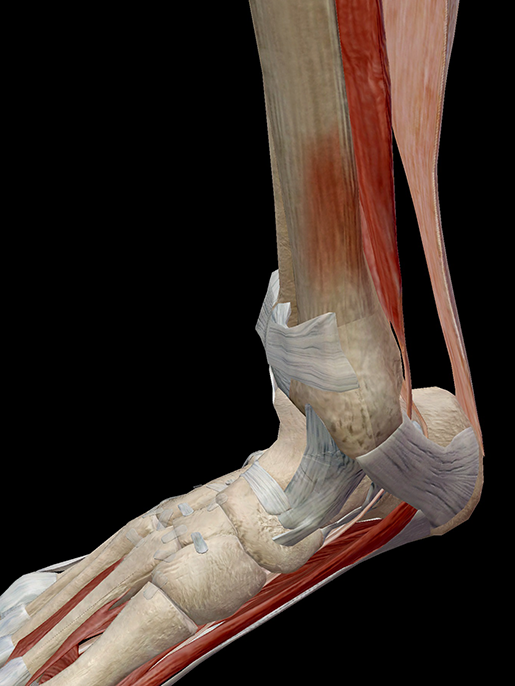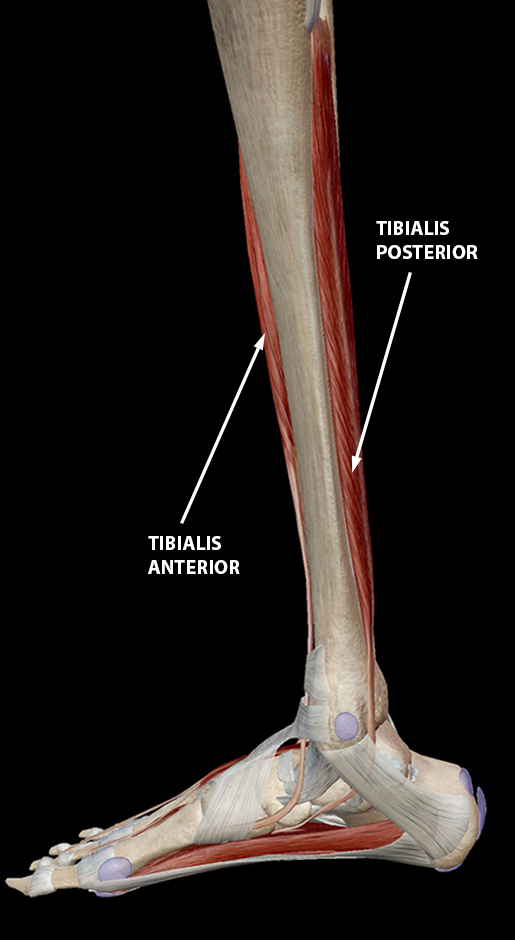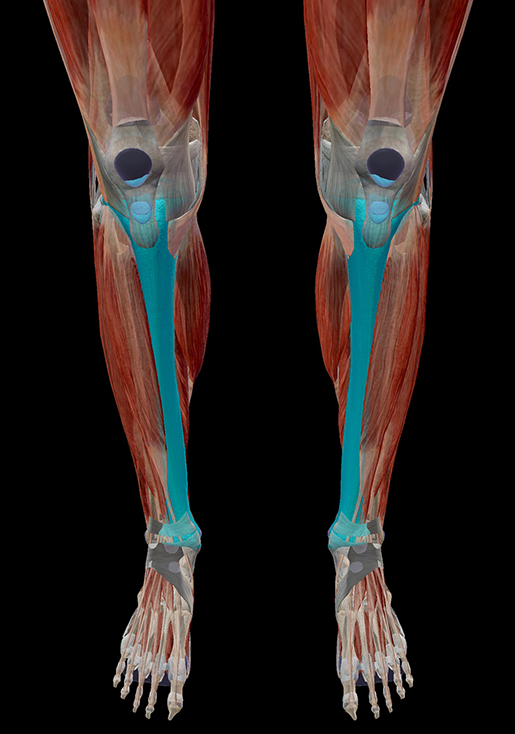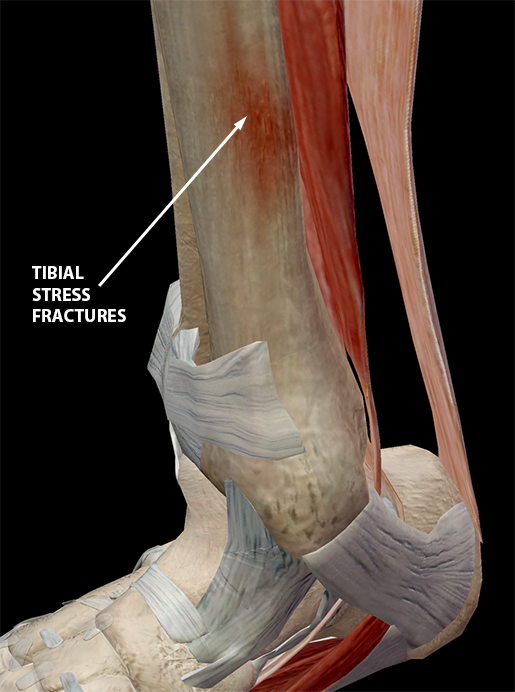Hold on to Your Tibias: The Anatomy and Causes of Shin Splints
Posted on 8/3/17 by Marian Siljeholm
At this point you might be sick of hearing about my days on the basketball court (ok, 50/50 on the court and the bench), but I’ve got one more tragic tale of attempted athleticism before I can lay this chapter to rest. It was senior year basketball tryouts, and given that I had been a devoted equestrian (if you say riding isn’t a sport you’ve never been on a horse, I’ll just get that out of the way now) year-round for the previous five years, I felt surprisingly prepared for the athletic gauntlet that was about to be thrown down. Supplementing my excitement was the fact that for the first time since middle school, I’d taken the winter off from the barn so that I could return to my much-loved and neglected passion of basketball.
What I failed to note in my enthusiasm was that while I may have considered myself at the peak of athletic prowess given years of core conditioning from horseback riding, this had done little to condition the muscle groups that basketball would demand. I may have been able to do sit-ups and wall sits until the cows came home, but my hurdling and short-distance sprinting abilities left much to be desired, as I was about to discover with disastrous consequences. And yet I was determined to make this season the best yet as it would certainly be my last. (I wasn’t delusional enough to believe that college basketball would ever be in the cards.) So when pain began radiating down my knees and through my shins on day three of tryouts I decided to do the worst possible thing: ignore it.
This of course was impossible, as anyone who has ever had the misfortune of developing shin splints can attest to: the pain is excruciating, and it gets worse the more you attempt to ignore it. When it finally became unbearable, I did the second worst thing, and took pain medication to mask the symptoms without knowing the cause. What I didn’t know, but could have easily discovered by going to a doctor, was that I had developed what many runners fear most: shin splints.

Image from Muscle Premium.
A musculoskeletal injury of the lower leg, shin splints can have multiple causes, though the principal and most obvious symptom remains constant: pain. The confusing and often misunderstood reality of the term “shin splints” is that it’s often misapplied to what’s actually posterior tibialis tendonitis, the precursor to shin splints, or to the stress fractures that can follow shin splints. With true shin splints, the muscles surrounding the tibia are strained sometimes to the point of tearing, leading, in extreme cases, to the tibia also sustaining tiny fractures due to the overuse of its surrounding connective tissue, specifically the tibialis posterior muscle, the tibialis anterior muscle, and the periosteum.
Intended to control the foot’s position during exercise by dorsiflexing (raising) the foot, and supporting the foot’s arch during weight-bearing exercise, the tibialis anterior muscle and the tibialis posterior muscle attach to the periosteum, a thin connective tissue that covers the bone surface. As it so happens, the periosteum contains a high concentration of nerve endings and blood vessels compared with the adjacent bone, making it a particularly sensitive and painful structure when it becomes inflamed (you’re not kidding).
 Image from Human Anatomy Atlas.
Image from Human Anatomy Atlas.
When the aforementioned muscles aren’t capable of handling the workload that the athlete is forcing them to do (intensive sprinting and hurdling after years of lack thereof would be a prime example), shin splints occur. In the early stages (day one and two of tryouts), it may simply seem that the muscles are tired and sore. But should excessive activity or training continue (day three and four of tryouts), eventually the periosteum becomes involved, causing greater pain, inflammation, and eventually small fractures in the bone that take longer to heal than a muscle injury alone.
So what causes this painful muscle overloading? Basketball tryouts alone? Certainly not. Let’s examine the three main culprits:
- Overpronation or excessive pronation: Pronation occurs when the arch of the foot flattens, which is a normal aspect of the method through which our feet (gotta love ’em) dutifully perform the enormous task of absorbing all contact pressure from the ground when we walk, run, or do anything really without outside support. The job of our tibialis posterior muscle is to keep the arch up, hence if the arch flattens too quickly or too forcibly during an activity, especially if this happens repeatedly, the muscle becomes overloaded.
- Poor core strength: This was certainly not my problem, however, it’s worth noting that issues further up the limb may also manifest themselves into injuries in other regions of the body (it is all connected after all, who knew?). As such, weak muscles around the knees, pelvis, or within the lower back can place extra stress and strain throughout your lower limbs as the weaker areas struggle to cope with extreme training loads, with your body then compensating by placing the stress on other areas.
- Excessive training: There may not be problems with your biomechanics, but if you’re not training appropriately you may run into problems regardless. This includes not just overtraining (having inadequate rest and nutrition between sessions), but any drastic change in training methods that your body finds hard to adapt to, making your muscles work harder as they condition themselves to the new style of training. This includes training at new intensities or longer durations, training on a new surface, wearing new footwear, or even just adapting to a new sport.
 Image from Human Anatomy Atlas.
Image from Human Anatomy Atlas.
The good news is, next time basketball tryouts roll around, you’ve got options besides sitting out or winging it and ending up sitting out as a result. Since treatment for the injury involves ceasing the stress-inducing activity, the most effective treatment is prevention; though perhaps not a helpful diagnosis for lost causes such as myself at the time, effective preventative measures for others less foolish include:
- Stretching: Especially within the key biological and yet here problematic process of pronation, tight calf muscles are a major culprit. How can one prevent tight calf muscles? You guessed it! Stretching. Also, if you don’t own a foam roller yet, or go to a gym that has one (or thirty), or even a roommate with one, what are you even doing?
- Footwear: I swear I’m not being paid under the table by any sneaker company, but seriously investing in the right footwear is worth it, especially if you’re planning on any kind of heavy use, basketball or otherwise. Minimalism might be all the rage, but footwear with poor arch support is an almost certain way to end up with shin splints and a whole host of other stress-related muscle injuries and complaints.
- Podiatry: If you know you’re prone to shin splints, or that you’ll be upping your daily athleticism in the near future, and especially if both are true, assessment by not only a doctor but someone who is actually a foot doctor (professionally known as a podiatrist) can make an enormous difference. He or she can prescribe orthotics, a custom-made insert for your shoes, to assist in the vital task of arch support that will greatly reduce your chances of developing the dreaded splints. He or she can also assess your running style and suggest changes to help long term, as well as taping your feet in such a way as to provide additional arch support.
- Athleticism: No one wants to hear this, especially me. But overall fitness, not only in surrounding musculoskeletal areas, has an enormous influence on your susceptibility to splints. This might not have been my issue with regard to core strength, but let my tale be a cautionary lesson regarding the importance of evenly distributed physicality if you’d like to avoid my painful fate. If such lopsided conditioning (so to speak) is unavoidable, at least make a valid attempt to condition the area in the lead-up to your athletic gauntlet of choice. I won’t bother lying to myself, or you dear reader, by pretending I couldn’t have worked in a run (or twenty) in the months leading up to tryouts; learn from my mistakes, friends.

Image from Muscle Premium.
Preceding my bout with the splints, my tibia had already seen as rough an adolescence as the most socially awkward, acne riddled of preteen, as I’d shattered it a few years prior, though I was assured that my subsequent splints were unrelated to my previous injury; there goes that excuse. But fast-forward a few years to tryouts and my tibia’s second round of torture could only be chalked up to idiotic, ignorant self-infliction. Moral of the story: when you have pain and inflammation, don’t ignore it. Or do, and end up like me, with stress fractures. In Greek tragedy fashion, ultimately my determination to play despite the cost landed me on the bench for the entire season. If nothing else, learn from my mistakes to avoid the embarrassment of hobbling into your doctor’s office (a week late) only for him or her to tell you your season is over and it’s entirely your fault. Can you say ... opposite of score?
Be sure to subscribe to the Visible Body Blog for more anatomy awesomeness!
Are you a professor (or know someone who is)? We have awesome visuals and resources for your anatomy and physiology course! Learn more here.
Additional sources:
- “Shin Splints.” Mayo Clinic. Mayo Foundation for Medical Education and Research, 21 July 2016. Web. 21 July 2017.
- Craig, Debbie I. “Medial Tibial Stress Syndrome: Evidence-Based Prevention.” Journal of Athletic Training. The National Athletic Trainers’ Association, Inc., 2008. Web. 21 July 2017.






